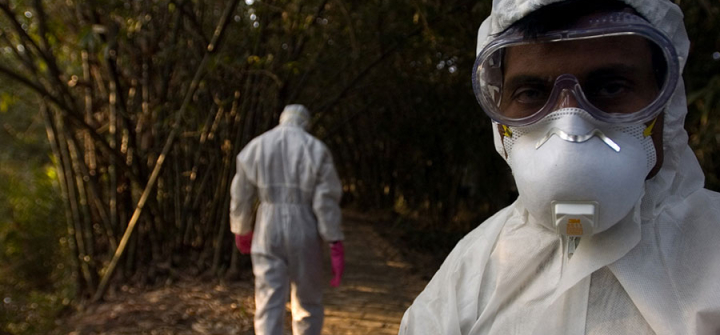The Pandemic Everyone Fears
If humanity is lucky, the next flu virus with pandemic potential will unfold somewhere quick to catch and contain the threat—a country with a strong public health service and well-stocked hospitals.
If we’re unlucky, a novel, lethal and highly infectious flu virus will break out in a crowded, unprepared megacity that lacks public health infrastructure. A fast-moving virus could burst from a city and catch a ride with international travelers before public health officials realize what is happening.
Location will likely prove a key factor in how quickly the virus is blocked, and how many people lose their lives first. People densely packed into megacities are like kindling for an outbreak of any disease, says influenza expert Amesh Adalja, MD, FIDSA. And poverty and conflict can compound the risks. But even for the world’s poorest, least-prepared cities, there are practical ways to head off the worst-case scenarios.
Lagos, Nigeria—Africa’s most populous city, with about 20 million people—certainly meets the “high spark-risk” description, but also illustrates keys to preparedness. “A highly communicable disease like influenza could spread like wildfire there,” and rapidly outstrip hospital resources, explains Daniel Duvall, Nigeria program director of the Division of Global Health Protection for the US CDC in Abuja. Although Lagos has some of Nigeria’s most developed public health infrastructure, most people have limited access to medical care, he says. And in a country with major gaps in primary care and low per capita spending on health, preventive vaccination is not immediately financially realistic. Therefore, outbreak preparedness centers on general strengthening of primary and secondary care and laboratories, aggressive education and hygiene campaigns, and build-up of prepositioned supplies—all muscles Lagos had the chance to flex during its brush with Ebola in July 2014.
“It’s to Nigeria’s credit that it responded to Ebola as well as it did and blocked a big outbreak in Lagos,” says Keiji Fukuda, MD, MPH, director of the School of Public Health at the University of Hong Kong. The WHO credits Nigeria’s swift, aggressive response to keeping cases in Lagos and Port Harcourt from spreading. But luck and timing played a part, Fukuda says—and influenza, with respiratory transmission, presents a whole different set of challenges from Ebola.
Specifically, avian influenza viruses like H7N9 top pandemic threat lists, including the CDC’s Influenza Risk Assessment Tool. While strains are mostly low-pathogenic in chickens, they could potentially evolve into much deadlier strains. “In terms of pandemic potential, an avian influenza virus is thought to be a likely candidate, based on prior pandemics,” says Adalja, senior scholar, Center for Health Security at the Johns Hopkins Bloomberg School of Public Health. “And since flu is contagious during its incubation period, once it starts to move it’s very hard to control—that’s something we saw with H1N1 [swine flu] in 2009. By the time people realized that this was a new pandemic flu virus, it had already spread all over the world.” The next virus might prove just as mobile as H1N1, but more lethal. But, Adalja cautions, “There are likely scenarios … but we can always be surprised.”
And influenza viruses excel at the element of surprise. Few would have guessed Mexico as the origin of that 2009 H1N1 pandemic, for example, notes Fukuda. That outbreak was recognized in San Diego—never considered a hotspot—when a little girl happened to seek treatment at a clinic participating in a study focused on diagnosis, Adalja explains. That’s why he believes it is important to build up the diagnostic capacity for frontline clinicians, and not be satisfied with non-specific diagnoses—failing to pin down the specific microbial cause. With respiratory viruses, there will be mild cases—like the first index H1N1 case—and more rigorous attention to diagnostics improves the chances of identifying a dangerous strain early.
The good news for humanity is that a range of scenarios, from low to severe, are possible when it comes to influenza outbreaks. “Certainly, the successive pandemics after 1918 (1967-68 and 2009, for example) have been progressively milder; in fact, a number of things that are different now—including the quality of medical care, antibiotics, better diagnostics—may mitigate the outcome,” emphasizes Kanta Subbarao, MBBS, MPH, director of the WHO Collaborating Centre for Reference and Research on Influenza in Melbourne, Australia. Some of it may come down to luck and location, but we can’t count on luck.
Fortunately, there are specific things we can do. Support for One Health initiatives, such as encouraging monitoring surveillance of animal outbreaks, can also help. Reporting poultry deaths, like participation in all global health efforts, is voluntary, but Subbarao has seen encouraging levels of commitment from governments. “Probably the biggest change I’ve seen in the last 15 years is how much more closely the agricultural sector works with the human disease sector; that’s been a positive change that needs to be supported around the world.”
The 2015 Middle East Respiratory virus (MERS) outbreak in South Korea also provides valuable lessons, as Fukuda notes. The strength and adaptability of South Korea’s basic health systems—surveillance, communication, and scientific systems—quickly became clear, he says, and MERS was contained.
Fukuda also wants to break the roller-coaster approach to pandemic preparedness: frenzied attention at the height of a threat that fades soon after the danger subsides. (Prime examples: the 1918 influenza pandemic, SARS in 2003, and Ebola in 2014.) Instead, he believes governments and institutions should approach outbreak preparedness like daily exercise. “Rather than getting ready for the Olympics, it’s a lot like daily exercising for your health—and we haven’t really institutionalized that kind of work.” That is why it took such an enormous effort to stop Ebola in West Africa, where the health, surveillance, and communications systems were all weak.
Weak health systems in impoverished countries aren’t the only things we need to worry about. Governments slow to release information—or quick to impose draconian, ineffective methods in misguided attempts to control the spread of a disease—would also undermine a pandemic response.
And while our social-media makes it easier to share news of illness, it also fuels rumors and a burgeoning distrust in science. Social media in the US, for example, helped feed the panic over Ebola 2014. Fukuda believes the US is in an even worse position now. “I’ll be pretty blunt about this,” Fukuda says. “There’s almost a concerted effort to create distrust about information, and that is—even for a country as advanced as the US—a big Achilles heel.” Amid the deteriorating political discourse, we risk losing a science culture—and that’s materially related to how well we confront the next pandemic, Fukuda concludes.
Join the tens of thousands of subscribers who rely on Global Health NOW summaries and exclusive articles for the latest public health news. Sign up for our free weekday enewsletter, and please share the link with friends and colleagues: http://www.globalhealthnow.org/subscribe.html
Healthcare providers leave a village after completion of a culling operation in response to a bird flu outbreak in Budgebudge, West Bengal, India. © 2008 Sudipto Das, Courtesy of Photoshare





